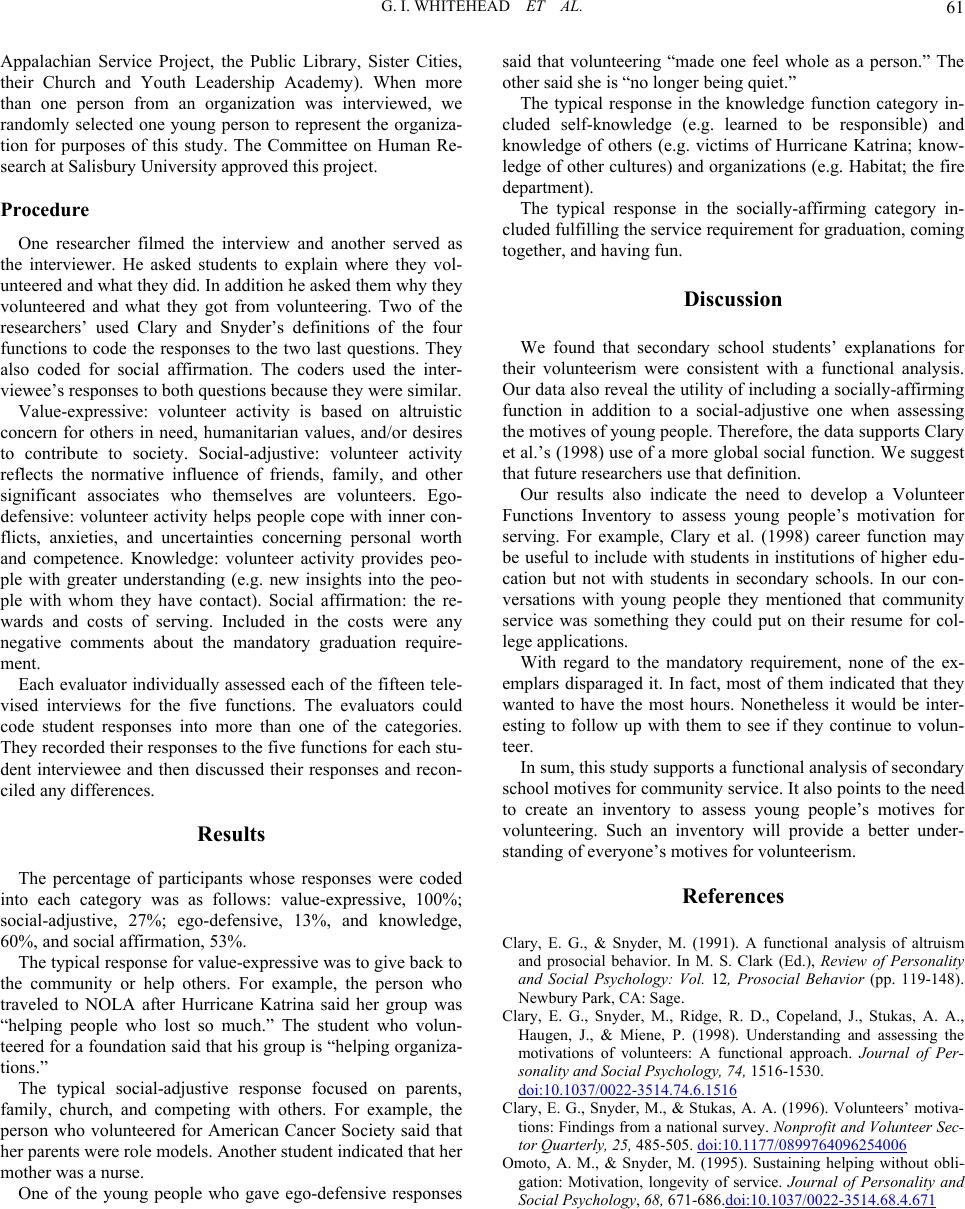
G. I. WHITEHEAD ET AL. 61
Appalachian Service Project, the Public Library, Sister Cities,
their Church and Youth Leadership Academy). When more
than one person from an organization was interviewed, we
randomly selected one young person to represent the organiza-
tion for purposes of this study. The Committee on Human Re-
search at Salisbury University approved this project.
Procedure
One researcher filmed the interview and another served as
the interviewer. He asked students to explain where they vol-
unteered and what they did. In addition he asked them why they
volunteered and what they got from volunteering. Two of the
researchers’ used Clary and Snyder’s definitions of the four
functions to code the responses to the two last questions. They
also coded for social affirmation. The coders used the inter-
viewee’s responses to both questions because they were similar.
Value-expressive: volunteer activity is based on altruistic
concern for others in need, humanitarian values, and/or desires
to contribute to society. Social-adjustive: volunteer activity
reflects the normative influence of friends, family, and other
significant associates who themselves are volunteers. Ego-
defensive: volunteer activity helps people cope with inner con-
flicts, anxieties, and uncertainties concerning personal worth
and competence. Knowledge: volunteer activity provides peo-
ple with greater understanding (e.g. new insights into the peo-
ple with whom they have contact). Social affirmation: the re-
wards and costs of serving. Included in the costs were any
negative comments about the mandatory graduation require-
ment.
Each evaluator individually assessed each of the fifteen tele-
vised interviews for the five functions. The evaluators could
code student responses into more than one of the categories.
They recorded their responses to the five functions for each stu-
dent interviewee and then discussed their responses and recon-
ciled any differences.
Results
The percentage of participants whose responses were coded
into each category was as follows: value-expressive, 100%;
social-adjustive, 27%; ego-defensive, 13%, and knowledge,
60%, and social affirmation, 53%.
The typical response for value-expressive was to give back to
the community or help others. For example, the person who
traveled to NOLA after Hurricane Katrina said her group was
“helping people who lost so much.” The student who volun-
teered for a foundation said that his group is “helping organiza-
tions.”
The typical social-adjustive response focused on parents,
family, church, and competing with others. For example, the
person who volunteered for American Cancer Society said that
her parents were role models. Another student i n dicated that her
mother was a nurse.
One of the young people who gave ego-defensive responses
said that volunteering “made one feel whole as a person.” The
other said she is “no longer being quiet.”
The typical response in the knowledge function category in-
cluded self-knowledge (e.g. learned to be responsible) and
knowledge of others (e.g. victims of Hurricane Katrina; know-
ledge of other cultures) and organizations (e.g. Habitat; the fire
department).
The typical response in the socially-affirming category in-
cluded fulfilling the service requirement for graduation, coming
together, and having fun.
Discussion
We found that secondary school students’ explanations for
their volunteerism were consistent with a functional analysis.
Our data also reveal the utility of including a socially-affirming
function in addition to a social-adjustive one when assessing
the motives of young people. Therefore, the data supports Clary
et al.’s (1998) use of a more global social function. We suggest
that future researchers use that definition.
Our results also indicate the need to develop a Volunteer
Functions Inventory to assess young people’s motivation for
serving. For example, Clary et al. (1998) career function may
be useful to include with students in institutions of higher edu-
cation but not with students in secondary schools. In our con-
versations with young people they mentioned that community
service was something they could put on their resume for col-
lege applications.
With regard to the mandatory requirement, none of the ex-
emplars disparaged it. In fact, most of them indicated that they
wanted to have the most hours. Nonetheless it would be inter-
esting to follow up with them to see if they continue to volun-
teer.
In sum, this study supports a functional analysis of secondary
school motives for community service. It also points to the need
to create an inventory to assess young people’s motives for
volunteering. Such an inventory will provide a better under-
standing of everyone’s motives for volunteerism.
References
Clary, E. G., & Snyder, M. (1991). A functional analysis of altruism
and prosocial behavior. In M. S. Clark (Ed.), Review of Personality
and Social Psychology: Vol. 12, Prosocial Behavior (pp. 119-148).
Newbury Park, CA: Sage.
Clary, E. G., Snyder, M., Ridge, R. D., Copeland, J., Stukas, A. A.,
Haugen, J., & Miene, P. (1998). Understanding and assessing the
motivations of volunteers: A functional approach. Journal of Per-
sonality and Social P sychology, 74, 1516-1530.
doi:10.1037/0022-3514.74.6.1516
Clary, E. G., Snyder, M., & Stukas, A. A. (1996). Volunteers’ motiva-
tions: Findings from a national survey. Nonprofit and Volunteer Sec-
tor Quarterly, 25, 485-505. doi:10.1177/0899764096254006
Omoto, A. M., & Snyder, M. (1995). Sustaining helping without obli-
gation: Motivation, longevity of service. Journal of Personality and
Social Psychology, 68, 671-686.doi:10.1037/0022-3514.68.4.671